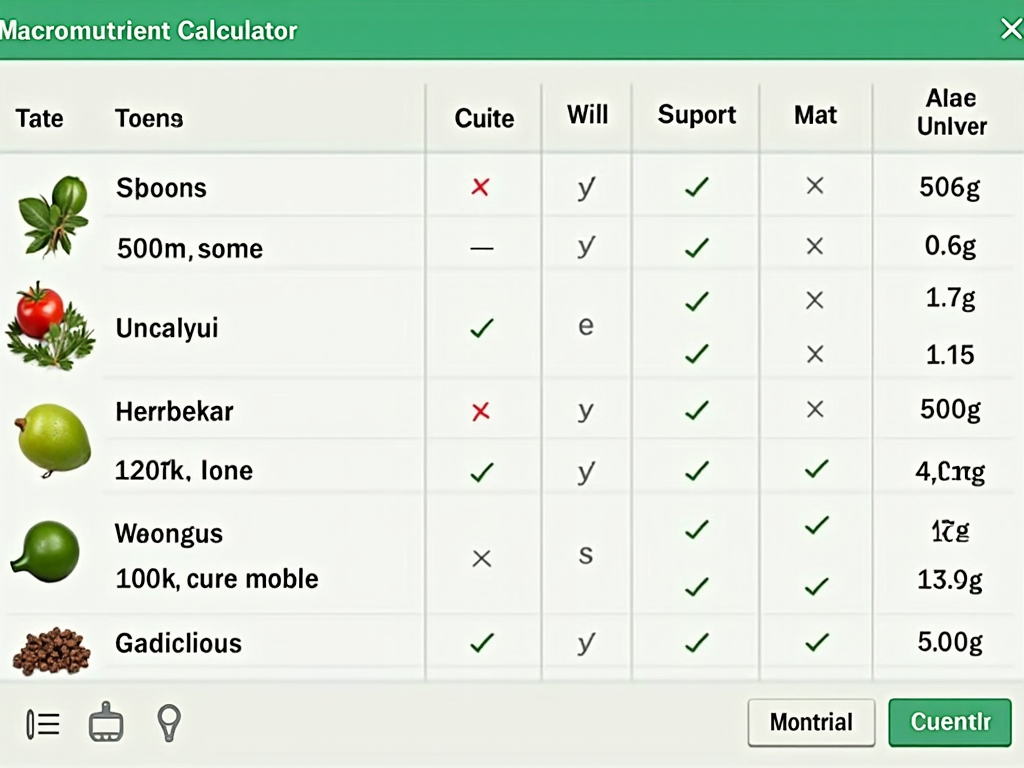In the complex world of fitness and nutrition, a macro calculator emerges as a game-changing tool for individuals seeking precise, personalized dietary guidance.
This comprehensive digital solution transforms abstract nutritional concepts into actionable, data-driven strategies.

Nutritional Alchemy: Engineering Your Perfect Body Composition
Free Macro Calculator: Customize Your Nutrition Plan Today
Key Takeaways:
- Definition A personalized nutrition tool calculating ideal macronutrient intake based on individual metrics.
- Macronutrient Basics Protein builds muscle, carbs provide energy, and fats support hormone production.
- Calculation Process Input personal data, determine daily energy needs, customize macro ratios.
- Goal-Specific Strategies Tailored approaches for weight loss, muscle gain, and performance optimization.
- Tracking Techniques Use nutrition apps, monitor intake, and adjust based on progress.
- Flexibility Adaptable system recognizing individual metabolic differences and changing needs.
Macronutrient Calculator for Weight Loss
Your Daily Macronutrient Targets for Weight Loss:
What Exactly is a Macro Calculator?

A macro calculator is an advanced nutritional algorithm designed to:
- Calculate precise macronutrient requirements.
- Customize nutrition plans based on individual metabolic profiles.
- Support diverse fitness goals like weight loss, muscle gain, and athletic performance.
The Science of Macronutrients: Breaking Down the Nutritional Foundations
Understanding Macronutrient Fundamentals
Macronutrients are the three primary nutritional components that fuel human metabolism:
- Protein:
- Supports muscle growth and recovery
- Essential for enzyme and hormone production
- Crucial for tissue repair
- Carbohydrates:
- Primary energy source for brain and body
- Supports high-intensity training
- Regulates blood sugar and insulin response
- Fats:
- Supports hormonal balance
- Facilitates nutrient absorption
- Provides long-term energy storage
🧮 Your Step-by-Step Macro Calculator Guide
Step 1: Calculate Your BMR
Your Basal Metabolic Rate (BMR) is the energy your body needs at rest. For Men:
javascript
BMR = 88.362 + (13.397 × weight in kg) + (4.799 × height in cm) - (5.677 × age)
For Women:
javascript
BMR = 447.593 + (9.247 × weight in kg) + (3.098 × height in cm) - (4.330 × age)
Step 2: Determine Your Activity Level
Choose your multiplier:
- 📱 Desk job, minimal exercise: × 1.2
- 🚶♂️ Light exercise 1-3x/week: × 1.375
- 🏃♀️ Moderate exercise 3-5x/week: × 1.55
- 🏋️♂️ Heavy exercise 6-7x/week: × 1.725
- 👥 Athletes training 2x/day: × 1.9
Step 3: Calculate TDEE
javascript
Total Daily Energy Expenditure = BMR × Activity Multiplier
🎯 Goal-Specific Macro Splits
Weight Loss Plan
- Calories: TDEE – 20%
- Protein: 2.2-2.4 g/kg
- Carbs: 2-3 g/kg
- Fats: 0.8-1.0 g/kg
Muscle Building Plan
- Calories: TDEE + 10%
- Protein: 1.8-2.2 g/kg
- Carbs: 4-7 g/kg
- Fats: 0.8-1.2 g/kg
Performance Plan
- Calories: TDEE
- Protein: 1.6-2.0 g/kg
- Carbs: 5-8 g/kg
- Fats: 1.0-1.5g/kg
💡 Pro Tips for Success
Tracking Tools
- Use a digital food scale.
- Download a reliable tracking app.
- Take progress photos weekly.
- Monitor energy levels
Common Mistakes to Avoid
- ❌ Not measuring portions
- ❌ Forgetting to track beverages
- ❌ Inconsistent tracking
- ❌ Not adjusting macros as needed
Advanced Macro Calculation Methodology
Step-by-Step Macro Tracking Process
Key Input Parameters
- Biological age
- Gender
- Current body composition
- Activity level
- Specific fitness objectives
Computational Approach
- Calculate Basal Metabolic Rate (BMR)
- Determine Total Daily Energy Expenditure (TDEE)
- Generate personalized macronutrient distribution
Comprehensive Benefits of Macro Tracking
1. Precision Nutrition
- Eliminates generic diet plan limitations
- Provides scientifically-tailored nutritional strategies
2. Metabolic Optimization
Potential outcomes include:
- Enhanced fat loss efficiency
- Improved muscle protein synthesis
- Balanced energy metabolism
3. Flexible Dieting Approach
The “If It Fits Your Macros” (IIFYM) methodology allows:
- Dietary flexibility
- Sustainable long-term nutrition management
- Psychological food freedom
Strategic Macro Calculation Scenarios
Weight Loss Strategy
- Moderate calorie deficit
- Higher protein preservation
- Controlled carbohydrate intake
- Strategic fat management
Muscle Hypertrophy Approach
- Calculated calorie surplus
- High-protein nutritional profile
- Complex carbohydrate integration
- Essential fatty acid supplementation
Athletic Performance Nutrition
- Periodized macro cycling
- Sport-specific energy requirements
- Performance-driven nutritional programming
Advanced Tracking Methodologies
Recommended Tracking Techniques
- Digital nutrition applications
- Precision food scales
- Comprehensive nutrition label comprehension
- Metabolic flexibility training
📊 Sample Meal Plan to Hit Your Macros
Breakfast (25% of daily macros)
- Oatmeal with protein powder
- Banana and almonds
- Greek yogurt
Lunch (30% of daily macros)
- Grilled chicken breast
- Brown rice
- Mixed vegetables
- Olive oil dressing
Dinner (30% of daily macros)
- Lean beef or fish
- Sweet potato
- Green vegetables
- Healthy fats
Snacks (15% of daily macros)
- Protein shake
- Fruit and nuts
- Rice cakes with peanut butter
Potential Challenges and Innovative Solutions
Common Macro Tracking Obstacles
- Initial complexity
- Tracking inconsistencies
- Metabolic adaptation
Proactive Mitigation Strategies
- Utilize default calculator settings.
- Consult sports nutrition professionals.
- Implement gradual, data-driven adjustments.
🎯 Next Steps
- Calculate your personal macros using the formulas above.
- Set up your tracking system.
- Create a meal plan template
- Start tracking tomorrow.
- Review progress weekly.
Remember: The best macro calculator is the one you’ll actually use consistently. Start with these guidelines and adjust based on your results and lifestyle.
Frequently Asked Questions
A: How frequently should macro calculations be updated?
A: Recalculate every 4-6 weeks or during significant body composition transitions.
A: Are macro calculators universally applicable?
A: While providing excellent baseline recommendations, individual metabolic variations necessitate personalized fine-tuning.
A: Can macro calculators accommodate specialized dietary requirements?
A: Modern calculators support diverse nutritional preferences, including vegetarian, vegan, and gluten-free approaches.
Conclusion: Your Nutritional Transformation Begins Now
A macro calculator transcends traditional dietary tools, offering a sophisticated, personalized approach to nutritional optimization. By understanding and implementing strategic macro tracking, you unlock unprecedented potential for fitness journey transformation.
Ready to Revolutionize Your Nutrition?
Explore our advanced macro calculator and embark on your personalized nutritional evolution today!
Disclaimer: Always consult healthcare professionals before starting any new dietary program.
Resources:
MyFitnessPal
Features a comprehensive database of over 18 million foods and provides detailed calorie and macro tracking capabilities with BMR calculations
Legion Athletics Tools
Offers 17+ free fitness tools including detailed calculations for body composition, calories, macros, and ideal weight loss rates2.
Precision Nutrition Calculator
Provides an evidence-based approach with an 18-page personalized report including detailed meal guidance and metabolic calculations
Bodybuilding.com Macro Calculator
Offers comprehensive explanations of flexible dieting principles and IIFYM approach with customizable macro ratios4.
IIFYM Calculator
Features a detailed calculator that considers lifestyle factors, cravings, and medical conditions for precise macro recommendations
Macro Friendly Calculator
Provides personalized nutrition plans with precise macro and calorie counts based on individual profiles and goals.
As a veteran fitness technology innovator and the founder of GearUpToFit.com, Alex Papaioannou stands at the intersection of health science and artificial intelligence. With over a decade of specialized experience in digital wellness solutions, he’s transforming how people approach their fitness journey through data-driven methodologies.
